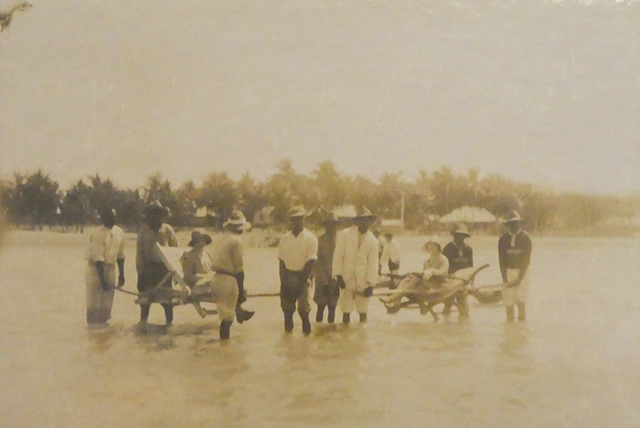4 March 2019 - 13 December 2019
Curated by Lindy Allen and Michael Aird
This exhibition focuses on images from an album donated to the Anthropology Museum by the Queensland Women’s Historical Association in 2017. The album is an official record of the “Inspection Tour of Aboriginal Stations in North Queensland and Torres Strait,1931” led by the Honourable Jens “James” Christian Peterson, Home Secretary in the Queensland government during the time the short-lived Country and Progressive National Party (1925-1936) were in office (1929-1932).

The official party set off from Thursday Island in June 1931 aboard the Queensland Government Ketch, Melbidir II visiting the Presbyterian mission of (Old) Mapoon and the Anglican mission at Cowal Creek (now Injinoo) before travelling through the Torres Strait stopping at eight islands, then to Cairns to “inspect” the Seventh Day Adventist mission station of Mona Mona, the Lutheran one at Mossman, and Anglican station of Yarrabah, before sailing south to the Aboriginal reserves of Fantome and Palm Islands. The Home Secretary had powers under section 9 of the Aboriginal Protection and Restriction of the Sale of Opium Act 1897 (the ‘Protection Act’) ‘to cause Aboriginals within any district to be removed to and kept within the limits of any reserve situated in the same or any other district’. These ‘inspection tours’ provided a key measure of the success of government’s efforts to solve its so-called ‘native problem’ by establishing reserves and missions and removing Aboriginal people to these.
The benevolent and paternalistic sentiments underpinning Aboriginal policy persisted through all administrations from the late 19th century through to the 1980s in Queensland. The photographs in this album emphasize the training of Aboriginal people and creation of localised industries and employment to enable the emergence of self-supporting villages where law and order prevails. This belies the reality of the separation of families with the imposition of dormitories and the strict and disciplined regimes that pervaded much of their lives and in which they had limited or no power.
Photographers travelling with these official parties documented the tours and photograph albums produced of these were then gifted with “The Compliments” of the Home Secretary. While it is unclear who received the albums, they unashamedly served to showcase the government’s perceived success in ‘helping [Aboriginal people] to a new and happier life’. Each album appears to be personalised, a second album of the 1931 Inspection Tour containing many but not all the same images and differing markedly in terms of their order. All the albums appear to contain the printed base map of Queensland adhered to the inside cover, and the pathway taken by the tour is marked in red ink.

This exhibition follows the tour through the images in the album. In addition to the places marked on the map, the album contains photographs of the Home Secretary’s visit to the ‘Inland Reserves’ of Woorabinda and Cherbourg and these are featured here. The 16mm film called 'The Native Problem in Queensland' that is shown as part of the exhibition was made in 1937 by the Department of Native Affairs in Queensland. This documentary similarly records Inspection Tours by the Honourable E.H. ‘Ned’ Hanlon, Minister for Health and Home Affairs in the subsequent Labor government under William Forgan Smith. It is said that Hanlon’s tour to the Torres Strait shown in this film was a response to a pearlers’ strike against the government’s protectionist policies. The Melbidir as the enabler of these tours is a crucial character in this history, and the last government launch named the Melbidir was removed from service following a controversial expose of government ministers using the vessel for a fishing junket, under the pretence of an Inspection Tour of Aboriginal Missions and Reserves.
